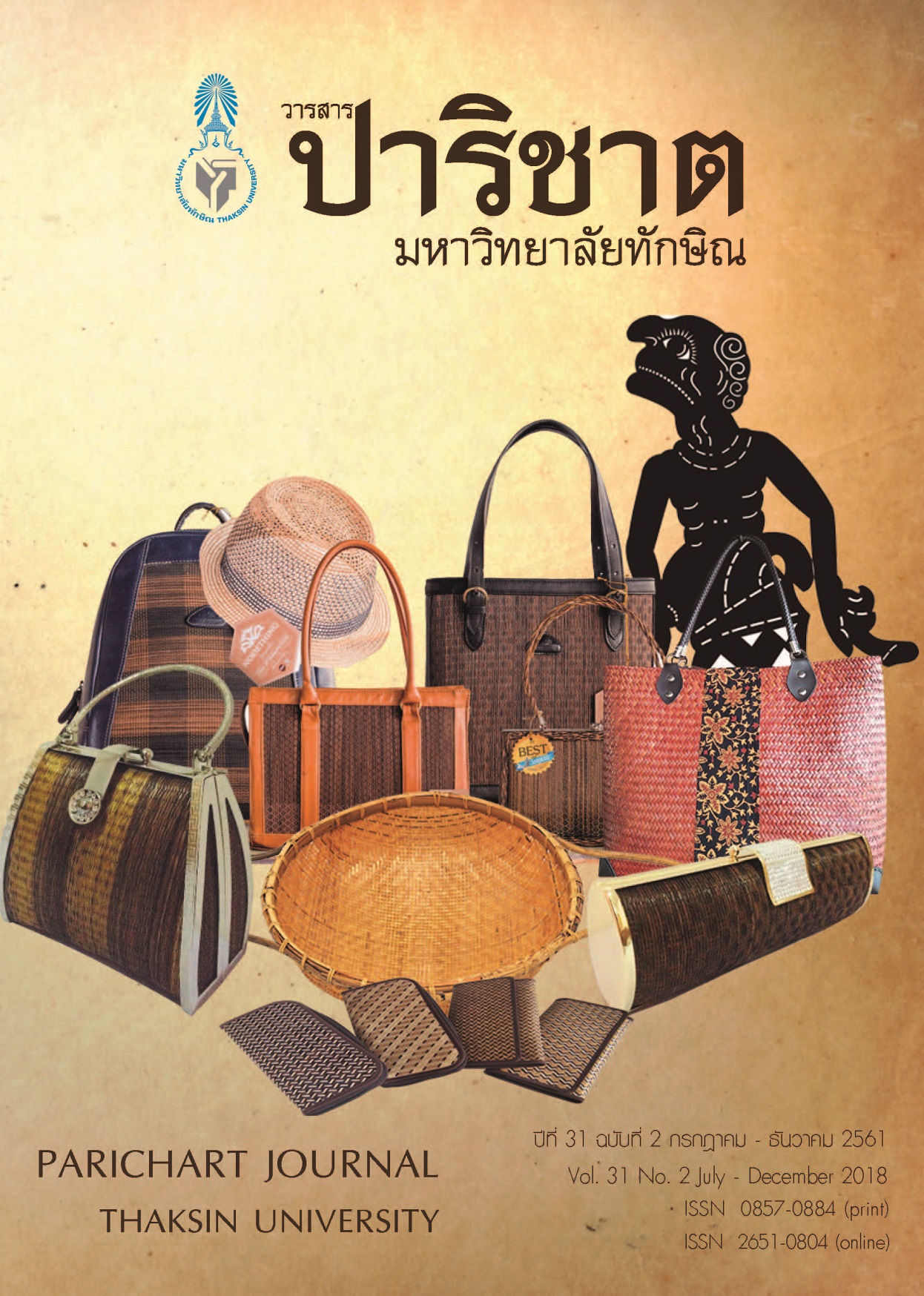Thai Traditional Songs on the Piano for Children’s Concentration and Memory
Main Article Content
Abstract
The purposes of this research were to compile Thai traditional
music to play on the piano for children’s concentration and memory. The
research was based on the historical musicology approach with the use
of ethnomusicology method in interviewing and gathering information.
The research resulted in 9 pieces of piano music for Thai traditional songs
that are well-known and popular among traditional troupes. The first
category is music used to accompany performances in the Southern part,
particularly Nang Talung (shadow puppet show): Patcha song (a type of
melody of Thai folk music), These song are commonly used by most Nang
Talung troupes out of a total of 12 songs usually played. The next category Khaek Mon Bang Khun Phrom, Ratri Pradap Dao, Khamen La-o-on, Khap
Mai Bando, and Kham Wan. Another category is music used to accompany
Rong-ngeng Dance of the Southern part which is Lakhu duwo; and last is
the song composed by the researcher called “Kluay Mai” or orchids which,
in addition to being played on the piano, ca
Article Details
References
[2] อเนก นาวิกมูล. (2550). เพลงพื้นบ้าน. กรุงเทพฯ: สารคดี บริษัทวิริยะธุรกิจ จำกัด.
[3] บุษกร บิณฑสันต์. (2554). ดนตรีภาคใต้: การถ่ายทอดความรู้ พิธีกรรม และความเชื่อ. กรุงเทพฯ: สำนักพิมพ์แห่งจุฬาลงกรณ์มหาวิทยาลัย.
[4] ณัชชา โสคติยานุรักษ์. (2546). ทฤษฏีดนตรีสากล. กรุงเทพฯ: สำนักพิมพ์แห่งจุฬาลงกรณ์มหาวิทยาลัย.
[5] ณรุทธ์ สุทธจิตต์. (2541). เพลงพื้นบ้านท่าโพ: เนื้อหาดนตรีและการสืบทอด. กรุงเทพฯ: สำนักพิมพ์แห่งจุฬาลงกรณ์มหาวิทยาลัย.
[6] กรมส่งเสริมวัฒนธรรม กระทรวงวัฒนธรรม. (2559). ประวัติครูควน ทวนยก ศิลปินแห่งชาติ สาขาศิลปะการแสดง ดนตรีพื้นบ้าน พ.ศ.2553. [แผ่นพับ]. สงขลา.
[7] Jordan Taylor Sloan. (2015). Science Shows How Piano Players ‘Brains Are Actually Different From Everybody Elses’. สืบค้นเมื่อ 1 มีนาคม 2560, จาก https://mic.com/articles/91329/science-shows-how-pianoplayers-brains-are-actually-different-from-everybody-elses.
[8] คมสันต์ วงค์วรรณ์. (2553). ดนตรีหนังตะลุง: กรณีศึกษาคณะนายอิ่ม จิตต์ภักดี (หนังอิ่มเท่ง) อำเภอควนเนียง จังหวัดสงขลา. สงขลา. คณะศิลปศาสตร์ มหาวิทยาลัยสงขลานครินทร์.
[9] สุทธิวงศ์ พงศ์ไพบูลย์. (ม.ป.ป.). หนังตะลุงสงขลา. สงขลา. มหาวิทยาลัยศรีนครินทรวิโรฒ.
[10] ควน ทวนยก (ผู้ให้สัมภาษณ์), จักรวิดา เหล็กนิ่ม (ผู้สัมภาษณ์), ที่สำนักศิลปวัฒนธรรม มหาวิทยาลัยราชภัฎสงขลา. สงขลา, เมื่อวันที่ 28 มีนาคม 2560.
[11] สุรชัย เหล่าสิงห์ (ผู้ให้สัมภาษณ์), จักรวิดา เหล็กนิ่ม (ผู้สัมภาษณ์), ที่สำนักศิลปวัฒนธรรม มหาวิทยาลัยราชภัฎสงขลา. สงขลา, เมื่อวันที่ 28 มีนาคม 2560.
[12] นันทวิทย์ นิ่มจงจิตร์ (ผู้ให้สัมภาษณ์), จักรวิดา เหล็กนิ่ม (ผู้สัมภาษณ์), ที่สำนักศิลปวัฒนธรรม มหาวิทยาลัยราชภัฏสงขลา. สงขลา, เมื่อวันที่ 28 มีนาคม 2560.
[13] ปรวิศ ประวัติ (ผู้ให้สัมภาษณ์), จักรวิดา เหล็กนิ่ม (ผู้สัมภาษณ์), ที่สำนักศิลปวัฒนธรรม มหาวิทยาลัยราชภัฏสงขลา. สงขลา, เมื่อวันที่ 28 มีนาคม 2560.
[14] ณรงค์ชัย ปิฎกรัชต์. (2542). สารานุกรมเพลงไทย. กรุงเทพฯ: โรงพิมพ์เรือนแก้วการพิมพ์.
[15] อติพล อนุกูล. (2550). บทเพลงรองเง็งคณะอัสลีมาลา. วิทยานิพนธ์ศิลปศาสตรมหาบัณฑิต มหาวิทยาลัยมหิดล. นครปฐม.


